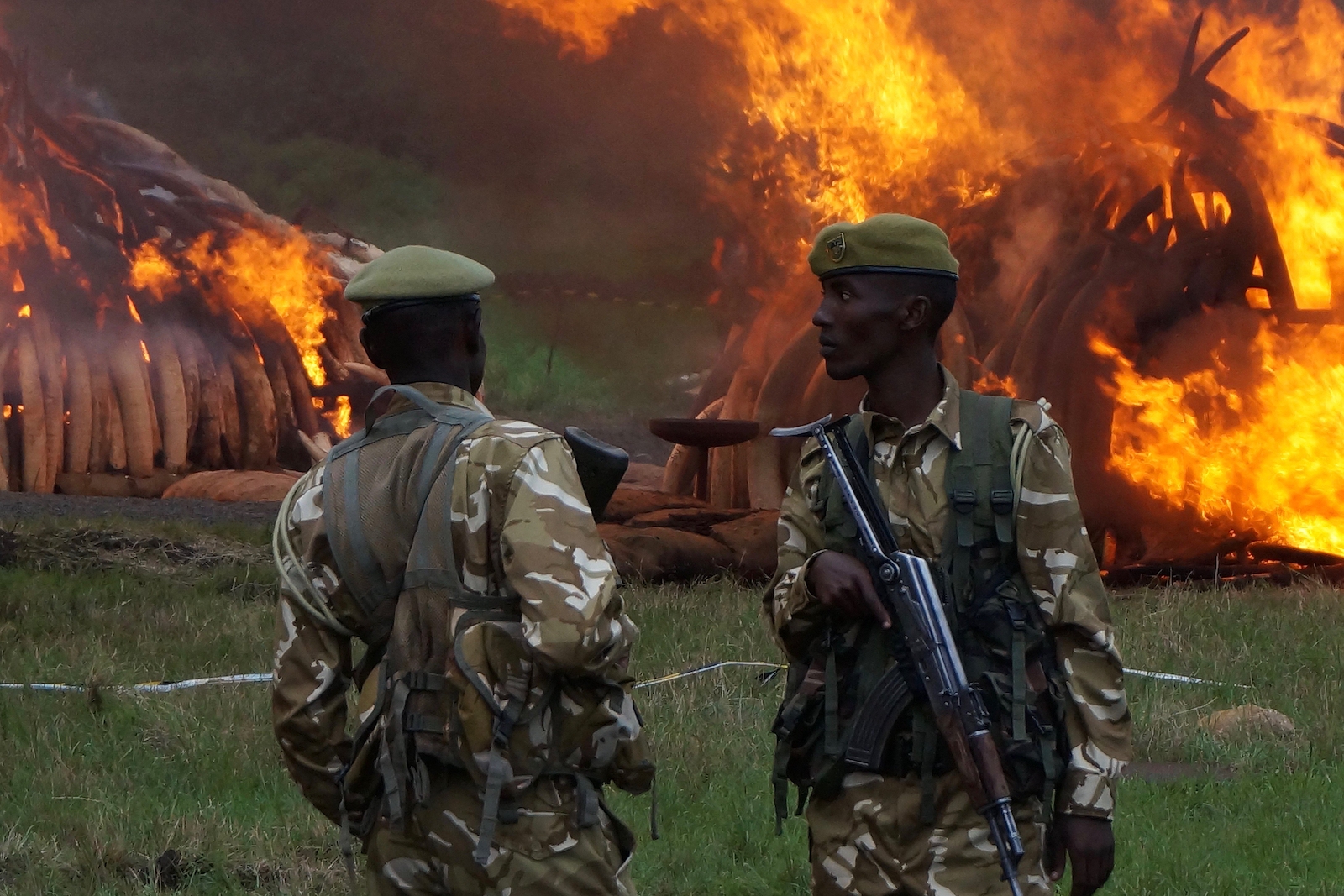
After Nine Years, a Kenyan Court Hands Down Guilty Verdict in Ivory Case
It was an atypical day in a Mombasa courtroom on March 23rd. The court was sitting to render a verdict in a nine-year-old ivory trafficking case. The two accused, their defence lawyers, a prosecutor, and members of the public were seated in the courtroom, one laptop and exterior speakers positioned on the prosecutor’s desk for all to hear and maybe watch some of the virtual session.
Fredrick Sababu Mungule and James Ngala Kassiwa had been charged with two offences under the East African Community Customs Management Act (EACCMA); conspiracy to contravene provisions of the EACCMA and bringing into customs area 638 pieces of ivory weighing 3,827 kg for export to Thailand in 2013.
Six weeks prior in a courtroom down the hall, both had been acquitted on other ivory charges under the EACCMA, stemming from a 1,833 kg seizure made in Singapore nine days after the one for which they were presently before the court.
On those charges, it had been ruled that the prosecution had not presented the court with the evidence required to prove a prima facie case, meaning they had not passed the threshold of introducing enough evidence to prove the basic elements of the case. On this backdrop, it appeared that another acquittal was likely.
That all changed, however, when Chief Magistrate Nyaloti asked the prosecutor if the court orderlies were present within the court. That question meant only one thing; Fredrick Sababu Mungule and James Kassiwa were going to jail.
While Nyaloti did not read out the entire written judgment as is often protocol, it was clear that in her opinion, the investigation and prosecution had connected the container with both of the accused; Mungule with the purchase of the container through the East African Commercial and Shipping Company of Mombasa and Kassiwa with deliberately allowing the container to pass into the port when presented with false documentation. The entry document had been previously used in 2012, for a shipment of broken glass.
The presiding magistrate found the two guilty of the first charge of “conspiracy to contravene provisions of the EACCMA” but not guilty of the second charge of “bringing into a customs area prohibited goods.”
The two accused were clearly shocked and even more so the following Monday when, after hearing their lawyers’ arguments on mitigation, were sentenced to two years in jail. While two years’ incarceration is better than the five years maximum permitted by statute, the body language of the accused indicated that were expecting something less.
To recap, on January 3rd, 2013, customs officials in Hong Kong announced that they had seized a sea container with 779 pieces of ivory weighing 1,330 kg hidden in a cargo of mazeras stones. The shipment had originated from Mombasa.
In response, Kenyan authorities put together a task force comprised of members of the Directorate of Criminal Investigation (DCI), the Kenya Wildlife Service (KWS), the Kenya Revenue Agency (KRA), the Kenya Port Authority (KPA), and the Lusaka Agreement Task Force (LATF).
On January 13th, it was discovered by a KPA clerk in Mombasa that there was another container within the port loading area that had logistical matches to the one seized in Hong Kong. Further investigation led to the discovery of the container for which the accused have been charged in this case.
A third container, again with logistical matches to the previous two, landed in Singapore within days of the Mombasa discovery and was verified to contain ivory. This time, 1,099 pieces and weighed 1,833 kg.
James Ngala Kassiwa and Gideon Naftali Osinyo found themselves in the Mombasa court on January 23rd and charged in relation to the first Hong Kong seizure and the second Mombasa seizure. Kassiwa was alleged to have permitted the trucks ferrying the ivory into the port while Osinyo “fixed” the paperwork to enable the loading of a container onto the ship. Fredrick Sababu Mungule, a ‘clearing agent,’ was arraigned two weeks later.
It was not until the following October 1st, that Mungule, Kassiwa, and Osinyo were arraigned for the third Singapore ivory seizure, prosecutors perhaps waiting for the confirmed repatriation of the 1,833 kg of ivory from Singapore that had arrived in Mombasa in August.
These three shipments, clearly the work of the same organization, totaled 6,990 kg of ivory and comprised 2,516 tusks and tusk pieces. The three containers were delivered to the port by two vehicles controlled by the same person. These same vehicles delivered 3 containers of ivory to Mombasa Port in 2015 and are the subject of a separate prosecution against Abdulrahman Mahmoud Sheikh and eight others.
All shipments had a cover load of mazeras stones. All shipments utilized similar false documentation. All shipments were arranged through the East African Commercial and Shipping Company of Mombasa, and all shipments were cleared by a quasi forwarding agent, Fredrick Sababu Mungule, through his business, Mwamba Freight Services. This ‘cover’ business name had not been registered with the KRA. Mungule had been previously associated with a 2,033 kg shipment of ivory that was seized in Bangkok and originated in Mombasa in 2011.
From a DNA analysis perspective, while the ivory from the Hong Kong shipment originated solely from savannah elephants in Mozambique, the Mombasa seizure originated from savannah elephants in Tanzania and Kenya.
Two tusks from the Mombasa shipment were genetic matches to two tusks in a seizure that originated in Kampala but was seized in Dubai. This Dubai seizure had three genetic matches to a 2,898 kg ivory seizure made in Mombasa in 2013.
This October seizure in turn had genetic matches with three other ivory seizures, one being a key 6,043 kg December 2012 Malaysian seizure, where a single container was found with significant quantities of savannah and forest elephant ivory and had transited Togo in West Africa from its origin in Mombasa. Certainly, the three 2013 ivory seizures under prosecution in Mombasa were part of a much bigger picture.
Regardless, it was decided that prosecutions relating to these seizures would be fragmented. The Hong Kong and Mombasa shipments were ‘consolidated’ into one prosecution, although the Hong Kong charges were never added to the new charge sheet rendering it essentially null and void.
The Singapore shipment became a second, separate prosecution. From the government’s perspective, the two prosecutions had two different lead investigators, two different prosecutors, who were heard by two different magistrates in two different courtrooms but with many similar witnesses and similar facts.
When Sababu, Kassiwa, and a third were acquitted due to critical prosecutorial failings in the Singapore seizure on February 11th, it became yet another major ivory case that had not been successfully investigated/prosecuted in Kenya. Since 2009, there had only been one major ivory trafficking case that had registered an initial conviction; the corrupted investigation of Feisal Mohamed Ali, whose guilty verdict was overturned on appeal in 2018.
This conviction under Nyaloti is the first solid conviction in a major ivory case in Kenya. But is this cause for celebration or embarrassment?
A two-year jail sentence after a nine-year trial, handed down to two small cogs of a much larger ivory cartel is hardly something about which to brag. Indeed, while there is no indication of a subverted verdict in this case, a prosecution that took nine years to complete, regardless of COVID-19, is no beacon of prosecutorial prowess, and more often than not, an indicator of subversion in play. In addition, lawyers for the Kenyan NGO, Wildlife Direct, had received death threats in 2017/2018 while covering this trial and the Singapore seizure prosecution making it clear that the involved cartel was concerned that their plan to subvert the trial process would be identified and called out.
At the time of writing, the news on the finding of guilt against Fredrick Sababu Mungule and James Kassiwa for their part in attempting to export 3,827 kg of ivory out of Mombasa, a shipment that was linked to a minimum of a dozen other multi-tonne ivory seizures in Kenya and abroad, has not made the Kenyan online news services. Two reporters from mainstream media outlets were in attendance in the Mombasa courtroom when the judgment was passed.
Perhaps therein lies the problem.
